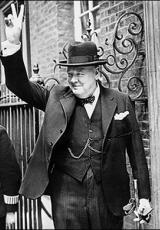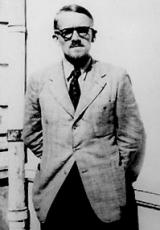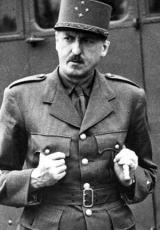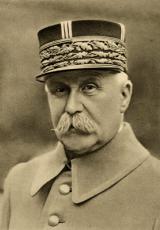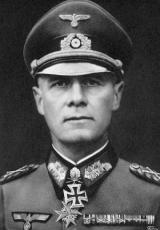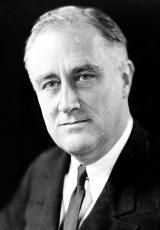1942: a turning-point?
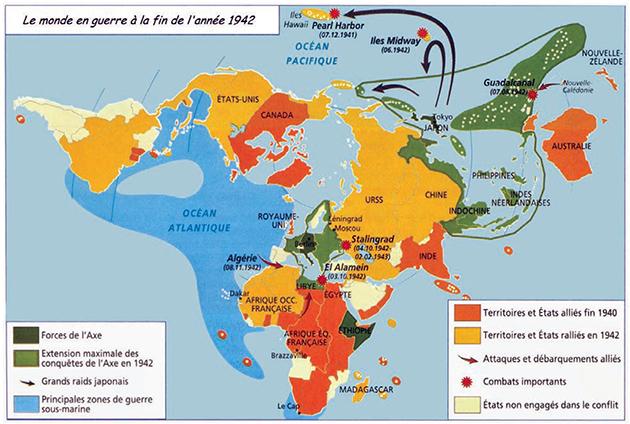
Contents
2 January: Manila, in the Philippines, is taken by the Japanese; Jean Moulin, General de Gaulle’s representative for the Free Zone, is parachuted into Provence.
11 January: the submarine war in the Atlantic intensifies.
18 January-17 May: Burma conquered by the Japanese.
20 January: the Wannsee Conference draws up the Final Solution to the Jewish Question.
21 January-2 September 1942: second German-Italian offensive in Libya.
Dismantling of the German Uhrig resistance group; publication by Les Éditions de Minuit of Le Silence de la Mer by Vercors (English title: Put Out the Light/The Silence of the Sea).
14 February: the 1st Free French Brigade stationed at Bir Hakeim
15 February: Singapore occupied by the Japanese.
19 February: the Riom Trial against the former leaders of the Third Republic begins.
20 February: the Japanese land in Timor.
23 February: seven members of the Musée de l’Homme network are executed at Mont Valérien.
28 February: the Japanese land in Java.
28 February-14 March 1942: Leclerc carries out a successful offensive on Fezzan, Libya.
Construction of the Sobibor extermination camp in Poland (the first convoys begin arriving in early May 1942).
1-8 March: conquest of Java by the Japanese.
27 March: first convoy of Jews from France deported to Auschwitz-Birkenau.
28 March: creation of the Francs-Tireurs et Partisans (FTP) national committee.
Osvald Pohl, head of the WVHA, the economics division of the SS, decrees prisoners should be worked to death.
17 April: the Germans order Pierre Laval’s return to power.
27 April: Pierre Brossolette departs for London.
Arrest of the members of the Herbert Baum resistance network; construction of the Treblinka extermination camp in Poland; publication of the first issue of Le Populaire in the Free Zone.
1 May: patriotic demonstrations in the Free Zone.
4 May: British attack on Madagascar.
8 May-2 July 1942: German offensive in Crimea; fall of Sevastopol.
12 May: Wallis and Futuna sides with Free France.
26 May: German-Italian offensive launched on the Gazala front.
26 May-11 June 1942: Battle of Bir Hakeim
27 May: assassination in Prague of Reinhard Heydrich, Reichsprotektor of Bohemia and Moravia, chief of police and head of the Reich Central Security Office.
29 May: German order requiring Jews over the age of six in the occupied zone to wear a yellow star.
Creation of Sonderkommando 1005, tasked with destroying all traces of the mass executions of Jews in Poland.
3-7 June: Battle of Midway (US victory).
10 June: German massacre of the inhabitants of Lidice, in Czechoslovakia, in retaliation for the death of Heydrich.
21 June: Tobruk, Libya, captured by the Germans; British troops retreat to El Alamein.
22 June: Laval’s speech stating his wish for a “German victory” over Bolshevism and outlining the relève policy (whereby prisoners of war would be released in exchange for French workers volunteering for Compulsory Labour Service in Germany).
28 June-18 November 1942: German offensive towards the Volga, the Caspian Sea and the Caucasus.
2-23 July: German operation in the region of Smolensk and Tver.
3 Juillet: Guadalcanal captured by the Japanese.
4 Juillet: Sevastopol captured by the Wehrmacht.
8 July: second edition of the Otto list entitled “Undesirable French literary works”.
14 July: patriotic demonstrations in the Free Zone; Free France renamed “Combatant France”.
16-17 July: Vel d’Hiv roundup, Paris. Nearly 13 000 Jews are arrested and held in the Vélodrome d’Hiver sports stadium, then interned in the Pithiviers, Beaune-la-Rolande and Drancy camps, before being deported.
22 July: the first Jews are deported from the Warsaw ghetto.
25 July: the Battle of the Caucasus begins.
4 August: first laws passed governing Compulsory Labour Service (STO) in Germany.
5 August: de Gaulle begins a tour of inspection of the Middle East and Africa.
7 August: US counter-offensive in the Pacific.
19 August: Anglo-Canadian raid on Dieppe (Operation Jubilee).
26 August: roundup of 6 500 Jews in the Free Zone, handed over to the Germans by the Vichy government.
31 August 1942-March 1943: arrest of most of the members of the Red Orchestra resistance network.
4 September: German offensive against Stalingrad and the Caucasus; law “on the use and orientation of the workforce”.
22 October: General Delestraint becomes head of the Armée Secrète (AS).
23 October: the Cherchell Conference; launch of the British offensive in Egypt and Libya.
Creation of the coordinating committee for the resistance movements in the southern zone; “official” distribution of Le Silence de la Mer.
2 November: Murphy-Giraud Agreements on the political, economic, military and financial terms of the Allied landings in North Africa.
8 November: Allied landings in North Africa (Operation Torch).
9 November: occupation of Tunisia by German-Italian troops begins.
11 November: invasion of the unoccupied zone by German and Italian troops (Operation Attila).
12 November: the Free French Air Force Normandie Niemen fighter group departs for the Soviet Union.
19 November: launch of Soviet counter-offensive on the Don and Volga.
19 November: 1942-2 February 1943: Battle of Stalingrad (Soviet victory).
22 November: Clark-Darlan Agreement on political and military cooperation.
27 November: scuttling of the French fleet at Toulon.
28 November: Reunion sides with Combatant France.
1 December: the Tunisian campaign begins; Organisation de Résistance de l’Armée (ORA) founded by General Frère.
14 December: Madagascar under the authority of Combatant France.
16 December: beginning of Leclerc’s conquest of Fezzan, Libya.
24 December: assassination of Admiral Darlan in Algiers.
28 December: French Somaliland sides with Combatant France.

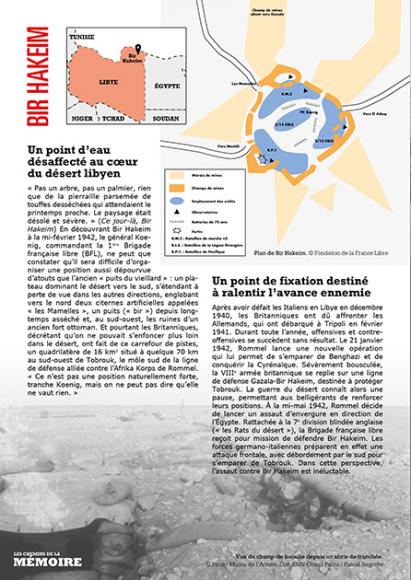
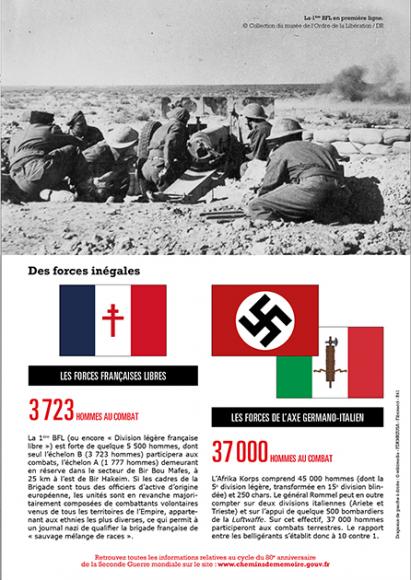
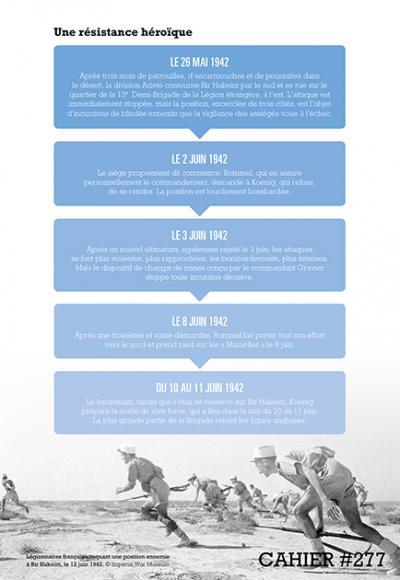
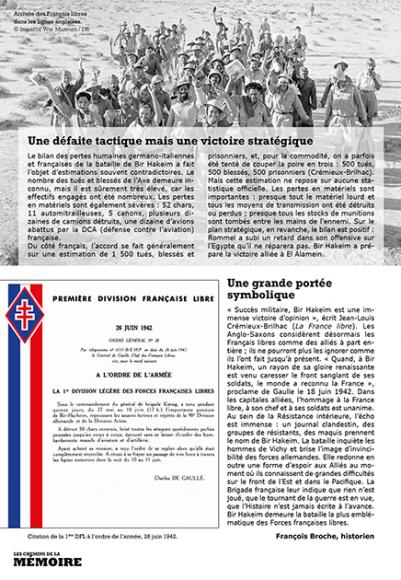
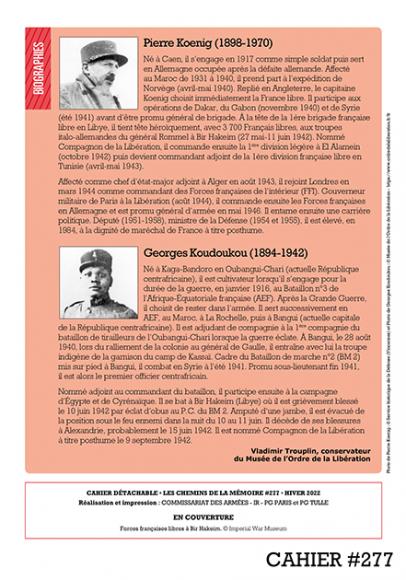
Summary
DATE: 1942
OBJECT: Second World War
OUTCOME: Extension of the conflict
NUMBER OF COUNTRIES INVOLVED: 38
If Japanese victory in the Far East and the advance of German troops into the Soviet Union made 1942 a difficult year for the Allies, it was also one of hope, with the German defeat at Stalingrad and the Allied landings in North Africa. In France, popular support for Vichy waned, as the Resistance organised.
1942 constitutes a key moment in the history of the Second World War and, more broadly, in the history of the 20th century. By becoming a genuinely global conflict, the war moved to a new level, changing direction, as the first Allied victories offered a glimpse of liberation in all the countries occupied by Axis forces. It also saw the establishment of the two superpowers that would be set to dominate the second half of the 20th century: the United States and the Soviet Union. In France, in addition to developments in the course of the war, domestic factors (the return of Pierre Laval to power in April 1942, the occupation of the southern zone in November) also make 1942 a time of major upheaval in national history.
The war becomes global and “total”
In 1941, the involvement of the British Empire and the French colonies that sided with Free France in the conflict, together with the German attack on the Soviet Union, had extended the war beyond the borders of Europe. But it was above all as a result of the surprise attack by the Japanese air force on the US air base at Pearl Harbor in the Pacific, on 7 December 1941, that the war became a genuinely global conflict. Not wishing to go against American public opinion, which had been in favour of isolationism since the end of the First World War, and to comply with the laws of neutrality adopted in the 1930s, President Roosevelt had until then been reluctant to enter the conflict, despite persistent appeals from Churchill. The Japanese attack on Pearl Harbor was like an electric shock and completely changed the situation. On 8 December, the United States declared war on Japan. True to the Tripartite Pact signed with Tokyo in 1940, creating what was known as the “Axis”, three days later Germany and Italy declared war on the United States.
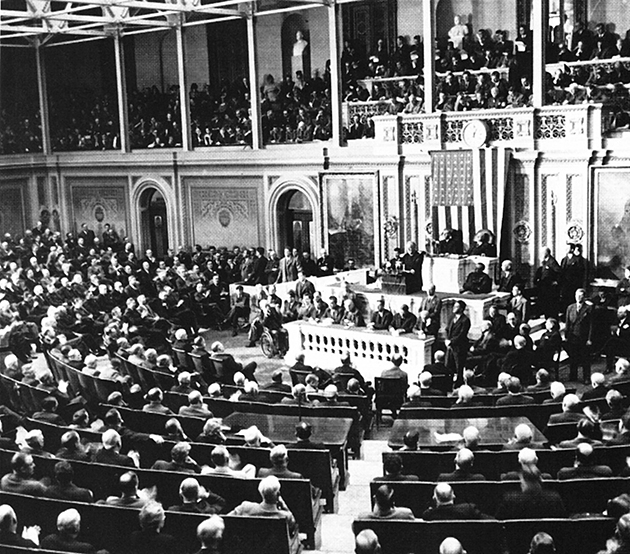
US president Franklin D. Roosevelt asks Congress to declare war on Japan, United States, 8 December 1941.
© TopFoto / Roger-Viollet
Thirty-eight countries representing half the world’s population were now directly involved in this immense conflict. Most of Latin America, which had until then kept out of the war, sided with the United States against Japan. And the “map of the war” expanded considerably, with a new theatre of operations: the Pacific.
The geographical scope of the conflict and the new power relations brought about by US participation in the Allied camp completely changed the outlook of the war. Up till then, the Germans could hope for a swift victory by means of lightning offensives intended to have a decisively disruptive effect on the enemy. They had done this in May-June 1940 on the Western Front and thought they could do it again in 1941 against the Soviet Union. But once the war began developing in increasingly distinct theatres of operations, involving a growing number of countries, the possibility of bringing it to a rapid close with a single decisive battle or offensive became increasingly remote. The war would therefore necessarily be long drawn-out, with a new dimension of “total war” requiring the mobilisation of economies and populations in order to withstand, then surpass, the enemy. In this context, economic and industrial aspects took on fresh importance, since the final victory would also be played out in the factories, where more weapons and hardware would need to be produced than the enemy in order to win.
The Axis swansong
Although it brought about a new situation and changed the power relations between the two camps, the United States’ entry into the war did not immediately alter the course of the war. The USA was not properly prepared for war, its soldiers lacked experience and switching the entire economy over to the war effort would necessarily take some time. The British and the Soviets, exhausted by the intense fighting that had gone on since 1940 for the former and June 1941 for the latter, resisted with increasing difficulty against the enemy offensives. Throughout the summer of 1942, then, the Axis forces continued to have the upper hand and to be on the offensive in the various theatres of operations, while the Allies remained on the defensive, even suffering a number of major setbacks that made it seem as if a total victory for the Axis powers might be possible.
In the Pacific, to begin with the United States suffered nothing but a succession of setbacks. In late December 1941, the Japanese launched an offensive throughout the Pacific and Southeast Asia. They landed in the Philippines, where General MacArthur’s forces were totally overwhelmed. After several months of resistance, MacArthur found himself forced to leave the Philippines to take refuge in Australia, which he regarded as utterly humiliating and vowed to return. After the fall of Hong Kong at the end of December 1941, the fall of Singapore in February 1942 constituted the biggest British defeat since the beginning of the conflict. Within the space of a few months, the Japanese took over the whole of Southeast Asia, with the conquest of Borneo, Java, Sumatra, Siam and Burma. It was not until June 1942, and the Battle of Midway, that the Americans managed to halt the Japanese advance, after six months of defeats and retreats.
Back in Europe, throughout the spring and summer of 1942, the German armies continued to give the impression of invincibility. The winter of 1941-42 had brought the German offensive, begun on 22 June 1941, to a standstill on the outskirts of Moscow. But with the return of more favourable weather conditions, the Wehrmacht launched a second offensive on the Caucasus and its oilfields, which seemed to confirm German superiority over the Red Army. In May 1942, the Germans broke through the Soviet lines. Eight Soviet divisions were driven back as far as the Sea of Azov. On 20 May, what was left of the Red Army in the north of Crimea retreated to the strait separating the Black Sea from the Sea of Azov, having 170 000 prisoners taken in the process. In early 1942, General Paulus and the 6th Army reached Stalingrad.
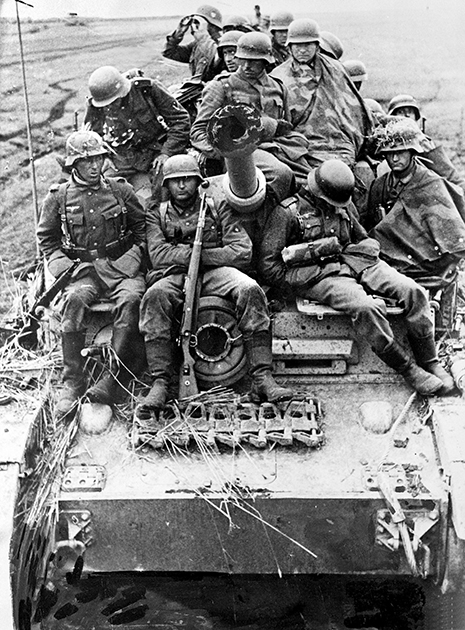
German infantrymen on a tank in the Don sector (Russian Front), July 1942. © Roger-Viollet
As this successful German offensive unfolded on the Eastern Front, the possibility of Allied landings in the West and the opening of a second front, as urged by Stalin, seemed as yet altogether impossible in 1942. The attempted landing by Anglo-Canadian troops at Dieppe, on 19 August 1942, was a fiasco. Although in reality it was no more than a raid intended to “test” the German defences, the event played into the hands of Nazi propaganda, which presented the “Atlantic Wall”, built by Organisation Todt all around the French coastline, as an impenetrable line of defences.
In North Africa, where the “desert war” that had begun in 1941 seemed to have reached a deadlock, Rommel seized the initiative once again in May 1942, when he launched an offensive on Egypt from Libya. Although resistance from Koenig’s Free French at Bir Hakeim succeeded in slowing the German advance, the capture of Tobruk by the Afrika Korps on 20 June 1942 constituted, for the British, who had 40 000 prisoners taken, the most serious military defeat of the war, along with the fall of Singapore. A few days later, Rommel was at the Egyptian border.
Les premières victoires alliées
Although the Axis forces continued their victorious progress throughout the first half of 1942, time was now on the side of the Allies, who possessed vast economic potential since they had been joined by the United States. Bit by bit, the American war effort began to produce results, with the manufacture of huge numbers of tanks, “Flying Fortresses”, aircraft carriers, trucks, guns and submarines. Meanwhile, having been caught off guard by Operation Barbarossa in June 1941, the USSR took advantage of its vast territory, its extensive reserves of raw materials and its economic potential to complete the conversion of its war industry in the Urals and beyond. Finally, from summer 1942 onwards, the considerable efforts made to protect shipping convoys succeeded in steadily changing the course of the “Battle of the Atlantic”. Allied losses from German submarine attacks, which up until then had been a serious threat to British supply lines, became more limited.
With the newly acquired economic superiority of the Allied camp, the balance of power gradually evened out, then swung in their favour. The Allies were able to contain the Axis offensives, then began seeing their first victories. On all fronts, the course of the war was reversed in late 1942, making that year the “bisector” of the conflict.
In the Pacific, after the naval confrontation at Midway put a stop to the Japanese advance, the landing of American troops at Guadalcanal in August 1942 was the first sign of a reversal of fortunes in the confrontation between Japan and the United States.
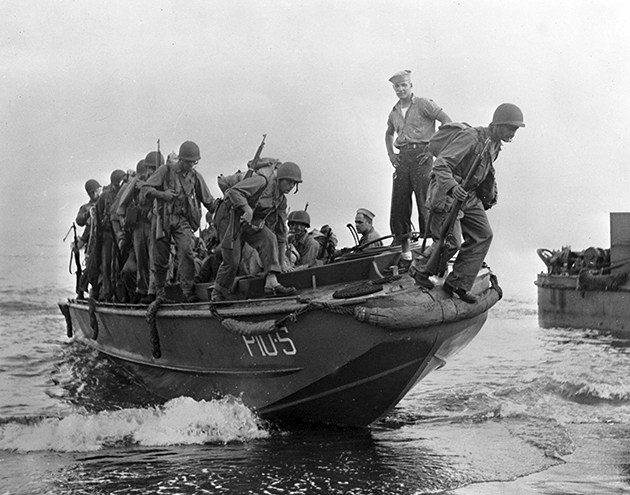
Troops of the US 25th Infantry Division land on Guadalcanal (Solomon Islands) to reinforce the Marines in the conquest of the island, late 1942. © Leemage via AFP
In North Africa, with the Afrika Korps 40 miles from Alexandria, Rommel was forced to halt his advance due to a lack of supplies and fuel. The British took advantage of the lull to reorganise. In October 1942, Montgomery launched a counter-offensive, taking back the territories conquered by the Afrika Korps in Libya. The Germans retreated to Tunisia, where they were caught in a pincer movement by Montgomery’s troops, to the east, and the British and American troops who landed in Morocco and Algeria as part of Operation Torch, in November 1942. The events of autumn 1942 in North Africa announced a new phase of the war, as Churchill would write in his Memoirs: “Before Alamein we never had a victory. After Alamein we never had a defeat.”
The same turnaround was seen on the Eastern Front at Stalingrad. As von Paulus’s 6th Army got bogged down in street fighting in an attempt to conquer the city neighbourhood by neighbourhood, the Soviets assembled a sizeable force to the east of Stalingrad, on the right bank of the Volga. In mid-November 1942, the Red Army unleashed a gigantic counter-offensive. Entirely surrounded, by early February 1943 the German 6th Army had no choice but to surrender. The Battle of Stalingrad and the loss of an army of 100 000 men were the Reich’s first major defeat and marked the beginning of a Soviet offensive that would take the Red Army as far as Berlin by February 1945.
In France, the rejection of Vichy intensifies
If 1942 marked a global turning-point in the war, it was also a time of major upheaval for France. French popular support for the Vichy regime had begun to wane in 1941, but Laval’s return to power in April 1942 further worsened its rejection. Convinced that Germany was on the point of winning the war, in spring 1942 Laval decided to revive collaboration in order to obtain concessions from the occupying power. Invested with greater powers than he had back in 1940 (he received the title of “head of government” and the key portfolios of foreign affairs, interior and information), Laval sidelined Pétain, who appeared more and more like a mythical image dissociated from power, despite continuing to hold the constituent power.
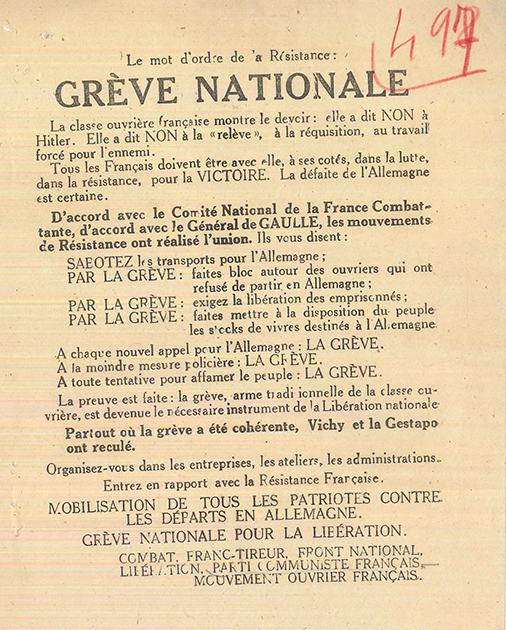
Pamphlet found at Oullins on 24 October 1942: “The watchword of the Resistance: national strike”, number 0025LM0183.
© SARDO - Centre National des Archives Historiques (CNAH), Groupe SNCF
Aside from a small number of milieux that were in favour of collaboration, Laval’s return to power prompted immediate opposition. His speech of 22 June 1941, in which he outlined the relève policy (whereby one prisoner of war would be released in exchange for three French workers who volunteered for Compulsory Labour Service in Germany) and expressed his desire for a “German victory, because otherwise Bolshevism would establish itself everywhere”, was not well received. Prefects’ reports told of “uneasiness”, a “bad impression” and “widespread astonishment”. If the principle of the relève, based on volunteering, was already unpopular, it was taken to another level with the entry into force of the Law of 4 September 1942 “on the use and orientation of the workforce”, which provided for French workers to be requisitioned according to professional criteria in order to meet Germany’s labour requirements. The first workers were requisitioned in early autumn 1942. This prompted large-scale demonstrations in the as yet unoccupied southern zone, where protest was easier. At Oullins, in the Lyon suburbs, 3 000 SNCF rail workers went on strike on 13 October 1942 in protest at the requisitioning of 30 of their colleagues. The strike spread to another 20 factories. Prompting the revival of certain forms of collective action that had disappeared since 1940, the Law of 4 September 1942 led to the first objectors being driven underground, to dodge the call-up that might have seen them sent to Germany. It was a phenomenon that would only intensify with the introduction of Compulsory Labour Service (STO) in 1943, which extended requisitioning to all French young people born between 1920 and 1922.
A “movement of social reaction” to the roundups of Jews
Along with the first requisitioning of workers, another event contributed to making the summer and autumn of 1942 a pivotal moment in the occupation of France. The first roundups of foreign Jews carried out by the Germans in 1941, restricted to the Paris area and involving only men, had prompted little disapproval. Yet all was set to change in summer 1942, as mass arrests spread throughout the country, becoming more visible and no longer sparing women and children.
On 16 and 17 July 1942, following an agreement signed between Vichy chief of police René Bousquet and his SS counterpart, Helmut Knochen, 4 500 French police arrested nearly 13 000 Jews in Paris, who were detained in the Vélodrome d’Hiver sports stadium or taken to the Beaune-la-Rolande and Pithiviers internment camps in the Loiret, then sent to Drancy, their final stop before being deported to the extermination camps. Between 6 August and 15 September 1942, over 10 000 Jews were also rounded up in the unoccupied zone and handed over to the Germans.
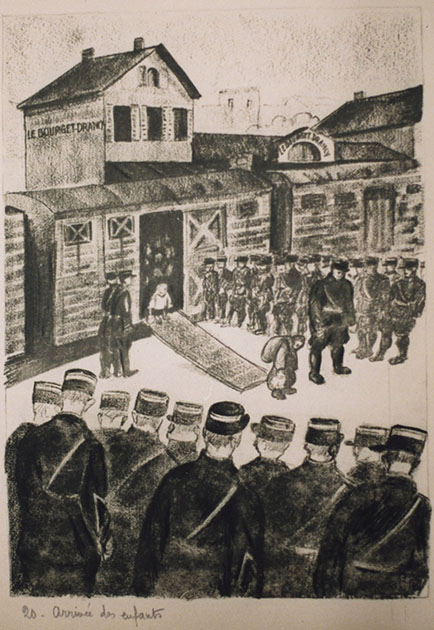
A Children arriving at Le Bourget-Drancy railway station, drawing by Georges Horan, 1942. © Mémorial de la Shoah / Georges Horan collection
The brutality of these roundups and the fact that they included the most vulnerable (the elderly, women, children) caused indignation. The Reformed Church mobilised to denounce the fate of the Jews. Senior members of the Catholic Church also spoke out. In his episcopal letter, the Archbishop of Toulouse, Monseigneur Saliège, denounced the horrors he had witnessed in camps in his region. Against this backdrop, acts of solidarity and mutual aid towards the persecuted became increasingly widespread. Historian Jacques Sémelin speaks of a “movement of social reaction” to describe these wide-ranging actions, from warning of a planned arrest to people agreeing to hide Jews in their homes. This solidarity played a decisive role in the rescue strategies that developed throughout the country to enable Jews to hide and escape. In some areas of the southern zone, small communes (Le Chambon-sur-Lignon in Haute-Loire, Dieulefit in the Drôme) became genuine havens for the persecuted.
A favourable setting for the Resistance
The different events of 1942 – with the nascent hope of an Allied victory and future liberation, and the last illusions about the Vichy regime fading away – proved favourable to the Resistance cause. It expanded its audience, and its actions, and worked towards greater unity. With Pétain’s increasingly compromising commitment to collaboration, any idea people may have had at the start of the Occupation that he might be playing a “double game” disappeared entirely. Those who had believed they could reconcile active resistance against the German occupier with support for Marshal Pétain (sometimes referred to as vichysto-résistants) now broke completely with Vichy. This was the case of Henry Frenay, for instance, who, in spring 1942, wrote in Combat, “everything is now clear”. The different resistance movements that emerged in 1941 joined forces to increase their effectiveness. Thus, at the end of 1942, the three main movements in the southern zone (Libération-Sud, Franc-Tireur and Combat) united their armed wings to form the Armée Secrète (AS).
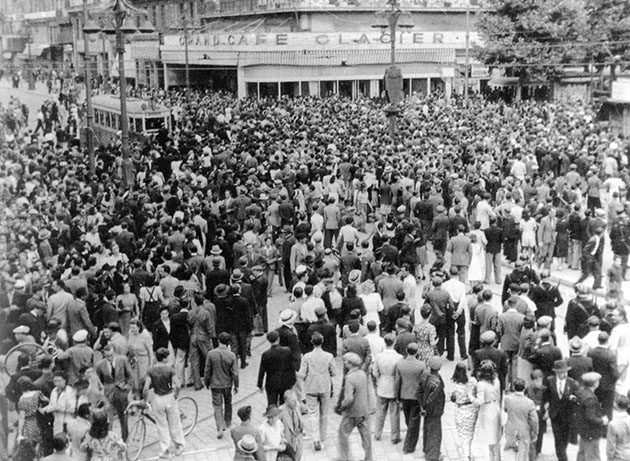
Anti-Pétain demonstration on La Canebière (Marseille), called by the BBC and the Resistance, 14 July 1942, number 76 W 116.
© Conseil Départemental des Bouches-du-Rhône / Archives Départementales - All rights reserved
The German occupation of the southern zone in November 1942, following the Allied landings in North Africa, went entirely against the 1940 armistice. Yet it prompted no opposition from the Vichy regime. As a result, many in the army and civil service felt released from their vows of loyalty and obedience to Pétain, made in 1940. Officers and senior civil servants joined the Resistance, which up until then had suffered from a severe shortage of experienced personnel. Meanwhile, a new organisation was set up in early 1943 – the Organisation de la Résistance Armée (ORA), formed mostly of former members of the Armistice Army.
Finally, as new issues arose in 1942, such as the rescuing of Jews and objectors forced into hiding to avoid compulsory labour service, the Resistance took on a new, more tangible role for many French people. New bridges were built between the Resistance organisations and French society. The former needed to continually expand their links with the population in order to increase the scope of their actions, while more and more people sought to make contact with the Resistance to obtain practical assistance, to avoid arrest or being sent to Germany as requisitioned labour.
All the trends and turnarounds seen in 1942, both globally (the shift in the conflict in favour of the Allies) and domestically (the progressive rejection of the Vichy regime by the French people and the rise of the Resistance), then became irreversible. Any hopes prompted by the first Allied victories of a rapid end to the war, possibly as early as 1943, were soon dashed, however. Expected in the summer or autumn of 1943, the Allied landings on the French coast would not in fact take place until June 1944. And the war would not end in Europe until May 1945, and in the Pacific not until September.
Author
Fabrice Grenard, historian, Fondation de la Résistance
Articles of the review
-
The event
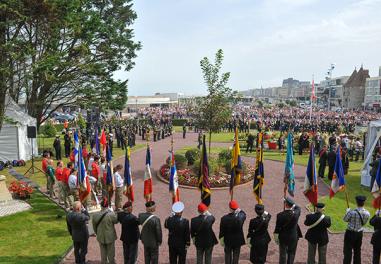
80 years after 1942
Read more -
The figure
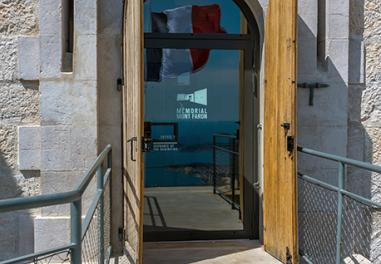
Memorial to the Landings and Liberation of Provence
A Major National Remembrance Site of the Ministry of the Armed Forces, the Memorial to the Landings and Liberation of Provence bears witness to the history of the Second World War. The episodes that took place in the Mediterranean in 1942 will be at the heart of its cultural programme this year. ...Read more -
The interview

Isabelle Zdroui
On 16 July 1942, Isabelle Zdroui escaped the Vel d’Hiv roundup. After escaping from the family home, she was hidden in a number of different children’s homes until the end of the war. Today aged 90, she continues to tell her story.
Read more


